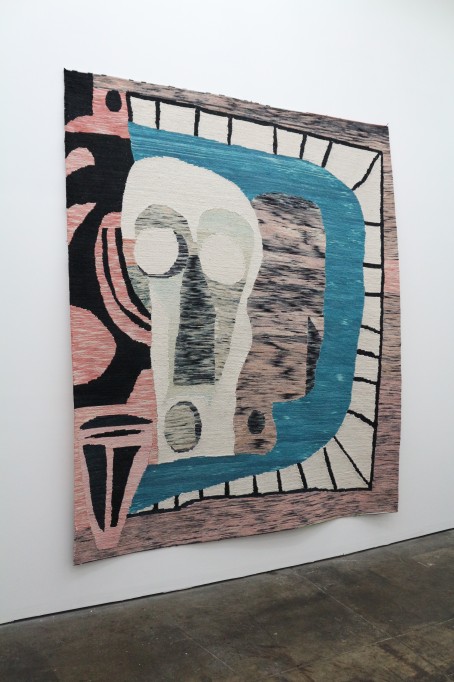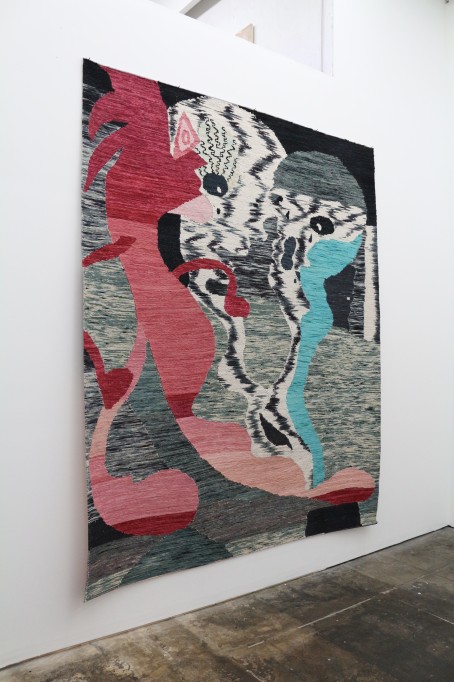
Yann Gerstberger, Let It Go (C.F. microvestido blanco), 2014. Cotton, natural dyes (grana cochinilla) and synthetic dyes, solventfree glue, vinyl banner, 116 x 94.5”. Installation view. Photo courtesy Michael Jon Gallery.
Michael Jon Gallery
May 31 – June 28, 2014
There are two elements of the work in Yann Gerstberger’s recent show that could warrant attention individually: the imagery recalling Miro or Picasso as much as ’80s graphics or ancient, totemic forms; and the work’s material presence as rugs or textiles. Both elements dominate the viewer’s initial encounter. Large rugs of thick strands of dyed mop-head material host mysterious, simple forms in a palette of pinks, magentas, sky blues, whites, tans, and blacks. The atmosphere is warm and light, and the objects suggest ancient modes of making even as they remain obviously contemporary.
But I don’t think the work holds up under either of these categories. They lack both the emphatic clarity of graphic images and the material necessity of an abstract composition in a unique medium. The strength of the work, to my eye, lies between: it is in the friction between image and materials that the works open themselves up to more sustained attention. When I first encountered them in the gallery, the works did not appear to be images at all. I could see the materials of their construction, but there was none of the fictive space necessary for an image. None of the abstract shapes immediately transformed into a body part or architectural detail.

Silent Boyfriend, 2014. Cotton, natural dyes (grana cochinilla) and synthetic dyes, solventfree glue, vinyl banner. 114 x 94.5 inches.
It took awhile for the images to begin to emerge—a cat-like animal with an umbrella in one, three twisted animal-or ghost-like shapes in a second, and a geometricized face superimposed over a cutaway box in the third. While the images are quite clear when seen on a computer, the thumbnails of these works have very little to do with the experience of seeing them. In the gallery, there was no gestalt. The images never resolved themselves to my eyes, and not for lack of giving them a good long look. With more room to back away the experience would have been quite different, but as it was, the close quarters of the gallery held the process of forming the image in suspension. And so the strange space that opens up when images begin to take shape never went away.
This is what makes the work so interesting for me. The images, in their half-emergent state, tug at the flatness of the materials, creating spatial instability and frustrating attempts to grasp the whole. It is here that the materials do their work: the stacks of yarn strands evoke lines of pixels on an old television screen or projector, creating a kind of low-resolution image that gestures toward, but does not clearly articulate, the graphic image. It also makes sense of some of the lack of determination
in the graphic images themselves, which, had they been clearer, might sit too comfortably within the quirky material presentation.

I’ve never been to Oakland, 2014. Cotton, natural dyes (grana cochinilla) and synthetic dyes, solventfree glue, vinyl banner. 114 x 94.5 inches.
The work leaves me with questions: What do the images have to do with the experience of trying to see them? Does the work need a small space to be seen, or does it hold up in a larger space? Nonetheless, there is something unquestionably rich in the seeing, and, I suspect, more to be gleaned from the images in time.










